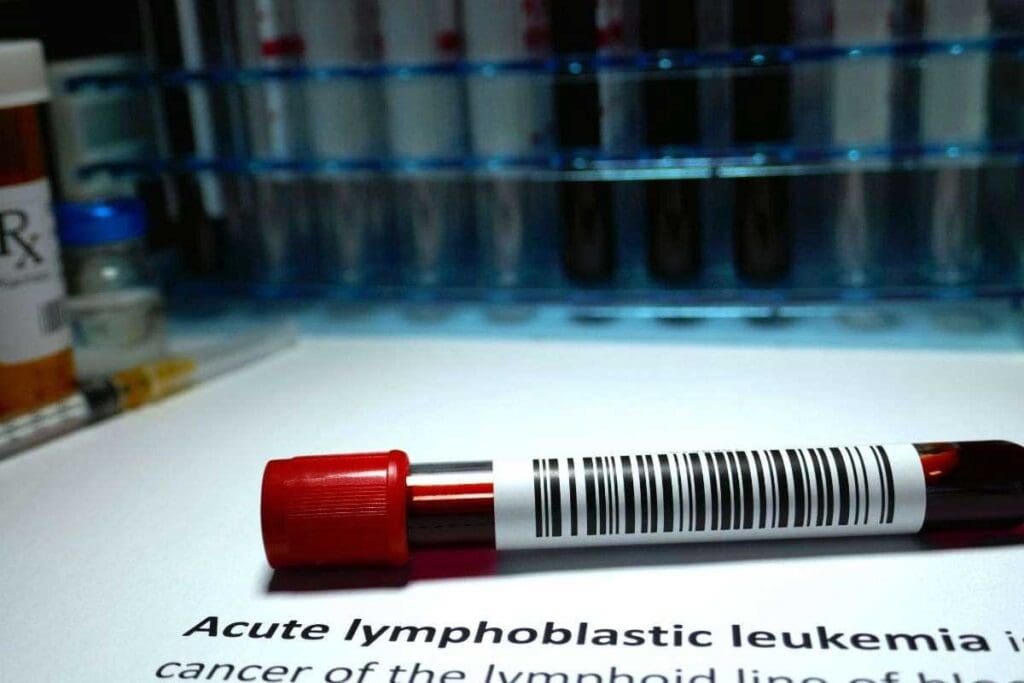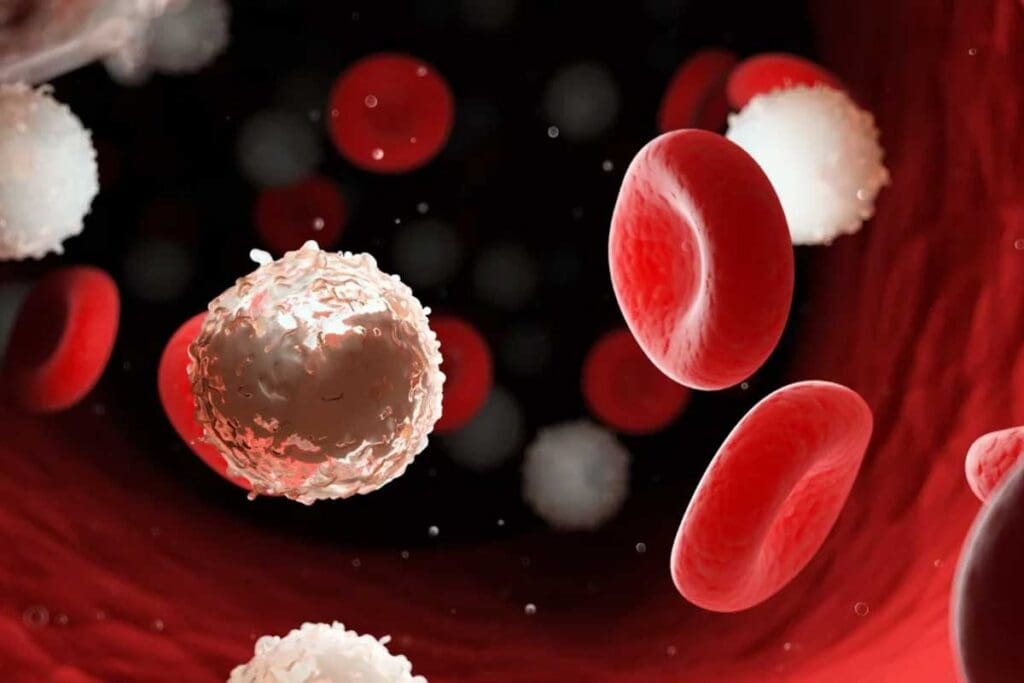Last Updated on November 20, 2025 by Ugurkan Demir

Getting a diagnosis of B-cell Acute Lymphoblastic Leukemia (B-cell ALL) can be scary for kids and parents. At Liv Hospital, we know how important it is to offer clear, caring advice. We help families through this tough time.
We aim to give world-class healthcare and support to international patients. Pre B Acute Lymphoblastic Leukemia is the most common type of B-cell ALL in children. Knowing its facts helps families make better choices.
In this article, we’ll look at seven key facts about B-cell ALL. We’ll cover what it is, its symptoms, how it’s diagnosed, treated, and what the future looks like. Our goal is to give families the knowledge they need to face this condition.

Learning about B-cell acute lymphoblastic leukemia (ALL) in kids starts with how blood cells are made. Blood cells are created in the bone marrow, a spongy tissue inside some bones. Knowing this helps us understand how B-cell ALL impacts children.
Blood cell development, or hematopoiesis, is how the body makes blood cells. This complex process turns stem cells into different blood cells, like red blood cells and white blood cells. White blood cells, like lymphocytes, help fight infections.
B-cell lymphocytes are a type of white blood cell that matures in the bone marrow. They are key in the immune system, helping fight infections. In B-cell ALL, the bone marrow makes abnormal B-cell lymphocytes that can’t work right.
In B-cell ALL, the bone marrow makes too many immature B-cell lymphocytes, called lymphoblasts. These abnormal cells take over the bone marrow, causing health problems. This disrupts the body’s ability to fight infections, carry oxygen, and stop bleeding.
| Normal Blood Cell Function | Effect of B-Cell ALL |
| Production of healthy white blood cells to fight infection | Production of abnormal white blood cells (lymphoblasts) |
| Normal red blood cell production to carry oxygen | Reduced red blood cell production, potentially leading to anemia |
| Normal platelet production stops bleeding | Reduced platelet production, potentially leading to bruising and bleeding |
Understanding how B-cell ALL affects the bone marrow is key for parents. It helps them understand the disease and why early medical help is vital. By knowing how leukemia disrupts blood cell production, parents can better support their kids during diagnosis and treatment.

Pre B Acute Lymphoblastic Leukemia is a type of cancer. It affects the blood and bone marrow. The bone marrow makes abnormal white blood cells that can’t fight infections well.
To understand Pre B Acute Lymphoblastic Leukemia, knowing the terms is key. B-Cell ALL is a leukemia that affects B cells, important for our immune system. “Pre B” means the leukemia cells are in an early stage, before they become B cells.
Breaking down the terms helps make the diagnosis clearer. Important terms include:
It’s important to know the difference between Pre B Acute Lymphoblastic Leukemia and other leukemias. The main differences are in the cell development stage and the leukemia cells’ genetic characteristics.
Some key differences include:
Understanding these differences is vital for patients and families. It helps them understand their diagnosis and what it means for treatment. By clarifying the terms and differences, we can better understand this complex disease.
B-cell ALL is the most common leukemia in kids. It makes up about 80-85% of all childhood leukemia cases.
Every year, around 3,000 kids in the U.S. get B-cell ALL. This disease hits kids aged 1-4 the hardest. Knowing these numbers helps us plan better.
| Age Group | Incidence Rate per Million |
| 1-4 years | 80-90 |
| 5-9 years | 40-50 |
| 10-14 years | 20-30 |
Kids with Down syndrome are more likely to get B-cell ALL. Also, radiation and some chemicals raise the risk of leukemia.
“Children with Down syndrome have a significantly increased risk of developing leukemia, particularly B-cell ALL.”
-According to current medical research
Genetics plays a big role in B-cell ALL. Some genetic changes mess up blood cell production. Pesticides and chemicals also increase leukemia risk.
Understanding B-cell ALL’s causes helps us find ways to prevent it. Research on genetics and environment is key to fighting this disease.
It’s vital to spot the signs of Pre B Acute Lymphoblastic Leukemia early. As a parent, knowing the early signs can greatly help your child’s treatment. This knowledge can lead to a better diagnosis and treatment plan.
Pre B Acute Lymphoblastic Leukemia can show symptoms that seem like common colds. But, if these symptoms last or get worse, it’s time to see a doctor. Look out for:
The signs of B-cell ALL can differ, but often include:
If your child shows any of these signs, get help right away:
Early detection is key to better treatment for B-cell ALL. If you’re worried about your child’s health, talk to your pediatrician or a specialist.
| Symptom | Description | Action |
| Fatigue | Persistent feeling of weakness | Monitor and consult if persistent |
| Unexplained Bruising | Bruising without cause | Seek medical attention if frequent |
| Frequent Infections | Recurring infections | Consult a doctor if recurring |
Learning about the diagnosis process for Pre-B Acute Lymphoblastic Leukemia can make families feel more ready. It starts with initial screenings and then moves to more detailed tests.
The first step is a complete blood count (CBC) test. It checks the levels of different blood cells. If the results are off, more tests are needed.
Blood tests can show signs of leukemia. This includes a high white blood cell count or low red and platelet levels.
A bone marrow biopsy is key in diagnosing Pre-B ALL. It takes a sample from the hip bone to look for cancer cells. This test shows the type and how far the leukemia has spread.
Tests on the bone marrow sample look for genetic changes in Pre B ALL. These tests confirm the diagnosis and give clues about the future.
After confirming the diagnosis, the next step is staging and risk assessment. This checks how far the disease has spread and what might affect the outcome. The risk assessment helps doctors create a treatment plan that fits the individual.
| Diagnostic Test | Purpose | Information Gained |
| Complete Blood Count (CBC) | Initial Screening | Measures levels of different blood cells, indicating possible leukemia |
| Bone Marrow Biopsy | Confirm Diagnosis | Looks for cancer cells, finds out the type, and how far it has spread |
| Molecular and Genetic Testing | Identify Genetic Abnormalities | Confirms diagnosis, gives clues about the future |
| Staging and Risk Assessment | Evaluate Disease Extent and Risk | Helps plan treatment based on individual risk factors |
Understanding the diagnosis and classification process helps families deal with Pre B Acute Lymphoblastic Leukemia. Each test is important for creating a good treatment plan.
The treatment for B-cell ALL has changed a lot, giving patients new hope. It now includes advanced protocols. Treatment for B-cell Acute Lymphoblastic Leukemia has several phases. Each phase has a specific goal in managing the disease.
The treatment for B-cell ALL is split into several phases. The induction phase aims to get rid of leukemia cells in the bone marrow. Then, the consolidation phase targets any cancer cells left to prevent relapse.
The maintenance phase is less intense but lasts longer. It helps keep the cancer in remission.
Targeted therapies have changed how we treat B-cell ALL. They target cancer cells without harming normal cells. Monoclonal antibodies and tyrosine kinase inhibitors are showing great promise.
Immunotherapy, like CAR T-cell therapy, is also effective. It’s a new way to treat B-cell ALL that has shown great results.
It’s important to manage side effects of B-cell ALL treatment. Side effects include nausea, fatigue, and a higher risk of infections. To manage these, medication, lifestyle changes, and supportive care are used.
Working closely with the healthcare team is key. They help develop a plan to manage side effects and improve outcomes.
Understanding treatment protocols and advances in targeted therapies helps patients and families. This knowledge lets them make informed decisions and get the best care possible.
Diagnosing B-cell ALL in infants under one year is very challenging. The disease is very aggressive at this age. It needs a special treatment plan.
Infants with B-cell ALL have special challenges. Their immune systems are not fully grown. This makes them more likely to get sick and have treatment problems.
Treatment for infants with B-cell ALL is adjusted. Chemotherapy doses are carefully chosen. The treatment’s intensity is also changed to avoid long-term side effects.
It’s very important to support the development of infants with B-cell ALL. They need to be watched closely. This includes their physical, emotional, and mental growth. They also need the right help.
Healthcare providers and families must work together. This way, they can give the best care to infants with B-cell ALL.
The outlook for B-cell ALL has greatly improved, bringing hope to families. Medical research and new treatments have boosted survival rates for kids with this leukemia.
Survival rates for kids with B-cell ALL are promising. Research shows that over 85% of children now survive. We’ve made big strides in fighting this disease.
| Age Group | 5-Year Survival Rate |
| 0-4 years | 90% |
| 5-9 years | 88% |
| 10-14 years | 85% |
Many things affect how well kids do with B-cell ALL. How well they respond to treatment, their leukemia’s genetics, and any health issues are key. Doctors use this info to create the best treatment plans.
Key factors that influence outcomes include:
Long-term care is vital for managing late effects and keeping survivors healthy. Regular check-ups help catch problems early. We focus on care that meets both physical and emotional needs.
Knowing about B-cell ALL’s prognosis and survival rates helps families face diagnosis and treatment. We keep working to improve our treatments, giving hope for better outcomes in the future.
The treatment for B-cell lymphoblastic leukemia is changing fast. New research and therapies are making a big difference. This brings hope to families dealing with this disease.
In the last ten years, breakthrough treatments have changed how we fight B-cell lymphoblastic leukemia. We now have better chemotherapy, care to help with side effects, and new drugs.
Immunotherapy has also become a key part of treatment. It uses the body’s immune system to find and kill cancer cells. This method is more focused and might be less harsh.
CAR T-cell therapy is a type of immunotherapy that’s showing great promise. It changes a patient’s T-cells to attack leukemia cells.
Studies show that CAR T-cell therapy can lead to full remissions in some patients. It’s a big step forward, but we’re working on handling side effects.
New clinical trials are exploring even more ways to treat B-cell lymphoblastic leukemia. They’re looking at combining old treatments with new ones and immunotherapies.
The outlook for treating B-cell lymphoblastic leukemia is good. We’re learning more about the disease every day. This knowledge could lead to even better care for patients and their families.
Living with B-cell acute lymphoblastic leukemia is more than just treatment. It’s about emotional, social, and family challenges. Families face many needs as they deal with this diagnosis.
Children with B-ALL feel many emotions, like fear and sadness. Supporting your child emotionally is key. Talk openly, listen to their feelings, and encourage them to express themselves through art or talking.
Parents should also take care of their own feelings. This helps create a stable home for their child. Getting help from family, friends, or counselors is helpful.
Going to school and keeping up with friends is hard with B-ALL. Kids might miss school for treatment. Talking to teachers and school officials helps keep up with schoolwork.
It’s also important for kids to stay in touch with friends. Visits, calls, and messages help them feel connected and supported.
Families with B-ALL can find many resources. Support groups and online forums are great for sharing and advice. Non-profit groups focused on leukemia offer help with money, counseling, and learning materials.
Having a strong support network is vital. This includes family, friends, doctors, and other families with B-ALL. A good network offers emotional support, practical help, and useful information.
| Resource Type | Description | Benefits |
| Support Groups | In-person or online groups for sharing experiences | Emotional support, advice, and community |
| Non-profit Organizations | Organizations dedicated to leukemia research and support | Financial assistance, counseling, and educational materials |
| Professional Counseling | Mental health professionals for individual or family counseling | Emotional support, coping strategies, stress management |
Using these resources and building a strong support network helps families with B-cell acute lymphoblastic leukemia.
Understanding Pre B Acute Lymphoblastic Leukemia is key for families dealing with it. We’ve looked at seven important facts about B-cell leukemia in kids. These include what it is, its symptoms, treatments, and chances of recovery.
Knowing these details helps families handle B-cell ALL better. Thanks to medical research, kids with Pre B Acute Lymphoblastic Leukemia have a better chance of living. New treatments like immunotherapy and CAR T-Cell therapy give families hope.
As we support families through this tough time, staying updated on B-cell leukemia research is vital. With the right info and support, families can face the future with hope and strength.
Pre B Acute Lymphoblastic Leukemia, or B-cell ALL, is a blood and bone marrow cancer. It makes immature white blood cells, called lymphoblasts. These cells can’t fight off infections well.
Symptoms in kids include feeling very tired, bruising easily, and getting sick a lot. They might also have swollen lymph nodes and bone pain. If your child shows these signs, see a doctor right away.
Doctors use several tests to find B-cell ALL. These include blood tests, a bone marrow biopsy, and genetic tests. These help find leukemia cells and understand the disease better.
Treatment for B-cell ALL includes several steps. It starts with induction, then consolidation and maintenance. New treatments like immunotherapy and CAR T-cell therapy are helping a lot. The best treatment plan depends on the child’s health and the leukemia’s type.
Today, most kids with B-cell ALL can survive, with over 85% chances of recovery. The success depends on how well the treatment works, the leukemia’s type, and the child’s health.
B-cell ALL affects the whole family, not just the child. It’s important to get support from doctors, support groups, and online resources. They can help with the emotional and practical challenges of the disease.
Yes, there are trials for new B-cell ALL treatments. These include immunotherapy and CAR T-cell therapy. They aim to improve survival rates and reduce relapse risk. Talk to your doctor about joining a trial.
Pre-B ALL is a specific type of ALL. It’s about the growth of pre-B cells. Knowing the differences between leukemia types helps patients and families understand their diagnosis and treatment options.
B-cell ALL messes up the bone marrow’s blood cell production. It leads to the growth of abnormal white blood cells. These cells are immature lymphocytes that can’t fight infections.
Subscribe to our e-newsletter to stay informed about the latest innovations in the world of health and exclusive offers!